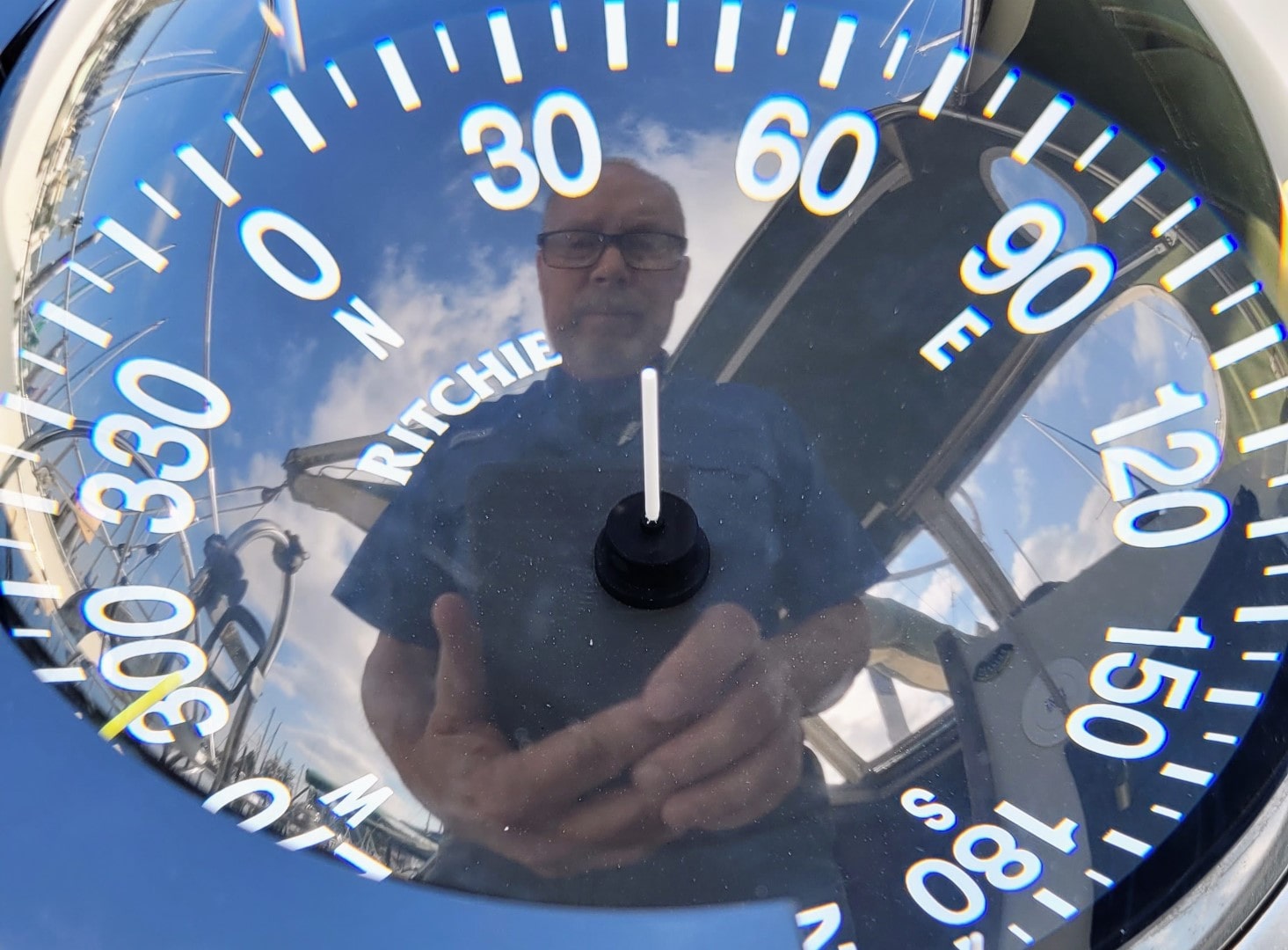
I have been waiting patiently (not really!) for my old Ritchie Globemaster compass to come back from the factory. (To be fair, the factory only took about a month to get my compass into the queue, fix it, and send it back. Impressive!) Avid followers may recall these two paragraphs from Next: Propane System…and More:
The axle for the steering wheel sounds gritty when I turn the wheel. It must need grease. I’ll get to that when I replace the compass. Why might I be replacing the $1,000 Ritchie compass? Because it leaked, and when I removed it from the pedestal, the sealing gasket gave way and all of the oil inside the compass became oil outside the compass. In that moment, I’m sure many cuss words were heard by our neighbors. Fortunately, I had some oil-absorbing clothes close by and I was able to stuff them into the cockpit drains to prevent any oil from going into the bay.
Ritchie offers a rebuilding service so this week, I shipped them the compass bits. I expect that in a few months, I’ll get the rebuilt compass back. The cost should be less than one-half of what a new compass would cost.

When I finally got the old compass cleaned up and sealed in bags, I took it to a local shipping company to send to the factory. I had some trouble with my shipper because I wanted to insure the damaged compass at the value of a new compass. Eventually, we came to an understanding, the shipment was packed and labeled, and it left the facility insured for $1,000.
Last week, the reconditioned compass arrived. It looks amazing. For a flat fee, the factory reconditioned the unit, essentially replacing anything that needed to be replaced, cleaning and polishing parts, and making sure everything looks and works as it should. The reconditioning service comes with a one-year guarantee, according to the factory representative I spoke with.
I’m surprised because this was a pretty old unit. If I read the label right, the serial number is just two digits: number 81. Nevertheless, they replaced the dome and gasket, refilled the oil (I assume it is oil) in the compass, replaced the red light needed for night operations, replaced a label, replaced the old metal base plate with a new plastic one, and polished everything up. It looks practically brand new for one-third the price of a new compass. I am very pleased.

I am struggling, though, to get two of the four stainless steel machine screws out of the cast aluminum steering pedestal. I need to do this because the new plastic base for the compass requires that those screws pass through the holes in the base plate. I’ve got the two screws drenched in Boeshield T-9 and am awaiting the delivery of a manual impact driver (reversible) to help persuade the screws to let go of the frozen embrace of the aluminum base. I am hopeful that by the time the driver arrives in a couple of days, the T-9 will have had enough time to seep down around the threads of the screws. My fingers and toes are crossed that some mild persuasion from the impact driver will break the screws loose without breaking the screws!
While I wait for the driver to arrive, I’ll buy some new stainless steel screws, hopefully with cap heads so I can get a socket on them the next time they need to be removed.
UPDATE September 18, 2022
Today, I finally got the two stuck bolts unstuck. I used WD-40 SPECIALIST PENETRANT and a manual impact driver to finally break them free. One was a bit easier to get loose but it still took an hour of pounding on the impact driver, applying penetrant, waiting, and repeating that cycle over and over. When that bolt (technically a machine screw) started to move, I almost cheered.
The other bolt was much more obstinate. That one took another hour of work. Over and over I pounded on the impact driver, peering closely at the head of the bolt to see if it had moved. And over and over I was disappointed. Finally, I decided to change my tactics. I reversed the impact driver and tightened the bolt. And then reversed it to loosen it. I kept repeating this action and over a 30-minute period — with frequent applications of penetrant — the darn thing finally started to turn.
I replaced the bolts with 1/4″ x 3″ machine screws (20 pitch threads) from Home Depot (stainless steel, of course). I lubricated each with some Permatex Anti-Seize Lubricant. I eased the new bolts into the old holes and backed them out a few times to make sure the threads were all cleaned up and that the lubricant was evenly coating the threads.
(One might wonder why so much drama ensued over stuck bolts. The reason is the old mount did not use these four bolts but the new one does. It has probably been decades since the old bolts were turned, and perhaps because of corrosion related to dissimilar metals [stainless steel against cast aluminum] two of the four bolts refused to budge when I first tried to remove them.)
Then the new compass went on with only one snag: the new night illumination light wires are not terminated but the wires feeding the old unit are terminated with spade terminals. I didn’t find any spare spade terminals in the electrical toolbox so I’ll buy new connectors and get this connection wired up.
UPDATE September 19, 2022
And done. New spade connectors are installed and tested. The new LEDs in the night illumination hood glow a nice red that will be perfect for navigating at night.





